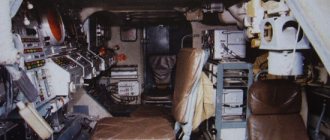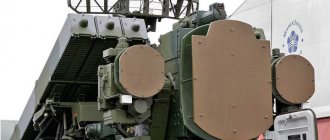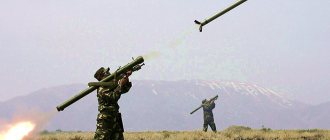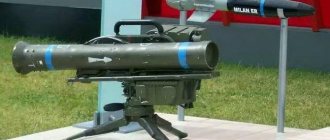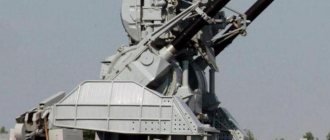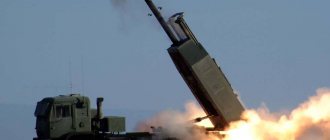The first brigade of Buk-M3 anti-aircraft missile systems in the Russian Armed Forces has been deployed in the Southern Military District (SMD). This formation became part of the 8th Combined Arms Army, which covers the Rostov region, the Caucasus and Crimea. The G8's likely enemy is the forces of NATO's southern flank. If necessary, the army can be quickly transferred to the west. “Buk-M3” is the most advanced air defense system in its class, experts say. It can intercept any targets at altitudes from several to tens of thousands of meters. Experts emphasize that these are defensive systems, and their appearance is designed to strengthen the Russian southern borders.
The sound cuts: Arctic tests of the “Dagger” have been completed
The complexes can be used against ground targets and enemy ships
History of creation
On January 13, 1972, the Council of Ministers of the USSR adopted a resolution to begin design work on the creation of new promising Buk anti-aircraft systems. The Soviet gunsmiths were given the task of creating a new military complex to replace the already used 2K12 “Cube”. In 1979, after successful tests, this air defense system (GRAU index -9K37) was adopted by the Soviet army. Design work on its modernization began immediately. The result of such activities was the creation in 1982 of a new military complex - Buk-M1. Unlike the basic version, it had an increased affected area. In addition, the upgraded complex could recognize three classes of targets: airplanes, helicopters and ballistic missiles. This military system became the first air defense system supplied to foreign customers. Finland received several units of such equipment. The air defense system entered service with the Soviet army in 1983. From 1993 to 1996, intensive modifications were carried out on the 9K37 project. The designers created a transitional modification of the Buk-M1-2.
Work to increase the range and height of hitting targets did not stop there. It was planned to create a system that would have improved characteristics. As a result of the modernization, a new military complex was designed, known as the Buk-M2 (a photo of the installation is presented in the article). In the USA, this air defense system is classified as “Grizzly-17”.
Design, characteristics
According to military experts, the most formidable air defense missile system, the 9M317 missile, was developed for the Buk-M2. It is designed for a range of up to 50 thousand meters. Length - 5.5 m. The mass of the rocket is 715 kg. Movement speed - 1230 m/s. The wingspan is 86 cm. During the explosion of an anti-aircraft guided missile, objects within a radius of 17 m are damaged. The 9M317 is equipped with an inertial-corrected control system, for which a new semi-active Doppler radar seeker 9E420 was created. The equipment is equipped with a rod warhead weighing 70 kg and a dual-mode solid propellant rocket engine.
Judging by the reviews of military experts, the missile, upon completion of complete assembly, is provided with a high level of reliability. Its operational life is at least ten years. During this time, missiles are not checked.
The installation is stored and transported to the place of its combat use in special fiberglass containers. 9M317 are effective at any time of the year. The rocket is not susceptible to precipitation, humidity and temperature.
Performance characteristics of the Buk-M1-2 air defense system
Radar with phased array (Buk-M2)
— Target detection range of at least 100 km with digital signal processing. — Simultaneous detection of 24 targets — Shelling of 6 targets base value, from 97th 10-12, upgrade limit 22 — Reaction time 15 s
Main characteristics of the 9M317 missile:
— For the first time, the ability to intercept Lance-type missiles has been provided — Weight: 715 kg — Maximum speed of targets hit: 1200 m/s — Maximum available overload for missiles: 24 g — Warhead weight: 50-70 kg
Maximum range of destruction of F-15 type aircraft 42 km - Probability of defeating a non-maneuvering aircraft 0.7-0.9 - Probability of defeating a maneuvering aircraft (7-8g) 0.5-0.7
Maximum range of destruction of Lance-type ballistic missiles (at altitudes 2-16 km) 20 km - Probability of destruction of OTR 0.5-0.7 - Maximum speed of destruction of an approaching Lance-type missile 1200 m/s - Maximum speed of destruction of a receding Lance-type missile 300 m/s With
Maximum engagement range of the AGM-86 ALCM missile: - at an altitude of 30 m - 20 km; at an altitude of 6000 m − 26 km - Probability of damage to missile defense 0.6-0.8
Maximum range of destruction of anti-radar missiles of the “HARM” type - 20 km - Probability of defeating PRR 0.6-0.8
— The maximum range of destruction of helicopters of the Hugh-Cobra type is 42 km (at a target speed of more than 50 m/s) — The maximum range of destruction of hovering helicopters is 10-12 km
What targets do 9M317 missiles hit?
The Buk-M2 complexes, equipped with 9M317, hit the following enemy aviation targets:
- Modern and advanced maneuvering aircraft. Chance of defeat: 95%.
- Helicopters providing fire support. Probability of destroying hovering helicopters: up to 40%.
- Hovering, tactical ballistic, cruise and aircraft missiles. Optimal altitude: 20 km. The probability of destroying tactical missiles is 70%, and cruise missiles: 80%.
- Unmanned aerial vehicles.
- An anti-aircraft guided missile destroys aircraft bombs at an altitude of up to 20 km.
- Enemy surface and ground radio-contrast targets.
The designers managed to expand the combat capabilities of the 9M317 by creating a new operating mode for it. If it is necessary to destroy any surface or ground targets in the missiles, the remote fuses are switched off.
About combat installations 9A317
In addition to anti-aircraft guided missiles, the Buk-M2 is equipped with self-propelled and towed firing systems. For self-propelled guns (SOU) 9A317, tracked chassis GM-569 are provided. These settings are used for detection, identification, auto-tracking and target type recognition. In addition, with the help of the SOU, the flight mission is practiced, radio-correcting commands are transmitted to the missile, and the firing result is evaluated. 9A317 can attack an object both as part of an air defense system and independently.
The SDA is a phased array antenna with electronic beam scanning. The target detection range is 20 km. The firing installation is capable of detecting up to 10 objects and firing simultaneously at 4 of them. An optical-electronic system and CCD-matrix television channels have been developed for the SOU. The installation is reliably protected from radio frequency interference and operates around the clock, which has a positive effect on the “survivability” of the air defense system. The SOU weighs 35 tons. Comes with four missiles. The crew consists of 4 people.
About the launch-loading installation 9A316
The Buk-M2 ROM is used as a transport-loading vehicle and launcher. 9A316 carries out pre-launch preparation and launch of anti-aircraft guided missiles.
This ROM is installed on the GM-577 tracked chassis. Wheeled semi-trailers with tractors are provided for towing. The launch supports are equipped with four missiles. Transport supports also have the same number of missiles. ROMs are charged within 13 minutes. The installation weighs 38 tons. Combat crew of 4 people.
About the controls
The anti-aircraft missile system is equipped with:
- Command post 9S510. Transported using a tracked chassis or a wheeled semi-trailer using a tractor. The reaction time takes no more than 2 seconds. Weighs up to 30 tons. There are 6 people in the crew.
- Radar station (radar) 9С36, which detects targets and guides missiles in wooded areas. The station is equipped with an antenna that rises to a height of up to 22 meters. The antenna is a phased array that provides electronic scanning. The station is installed on tracked chassis or on wheeled semi-trailers with tractors. The radar detects a target at a distance of up to 120 km. The station is capable of simultaneously detecting up to 10 targets, identifying four priority ones. On tracked chassis, the station weighs up to 36 tons, on wheeled ones - 30 tons. The crew has four people.
- Radar station 9S18M1-3, performing target detection. It is a phased waveguide-slot array. The station operates in several stages. First, the airspace is scanned by a beam in the vertical plane. Then the received data is transmitted to the command post using telecode lines. Detection range – 160 km. The review lasts for 6 seconds. Especially for automatic protection against active interference, the station is provided with instantaneous pulse adjustment and blocking of range intervals. The station weighs up to 30 tons. To transfer it from a combat position to a traveling position and vice versa, five minutes is enough. The crew includes three people.
9K317 Buk-M2 medium-range anti-aircraft missile system
Composition of the 9K317 Buk-M2 complex:
- combat weapons anti-aircraft guided missiles 9M317 (see.
), - self-propelled firing units (SOU) 9A317 and 9A318 (towed),
- launch-loading units (ROM) 9A316 and 9A320;
- command post 9S510,
The 9K317 complex provides for the use of two types of firing sections:
- up to 4 sections consisting of 1 self-propelled gun and 1 ROM, providing simultaneous fire at up to 4 targets (relief height up to 2m);
- up to 2 sections consisting of 1 RPN 9S36 and 2 ROMs, providing simultaneous firing of up to 4 targets (relief height up to 20m).
Ready time from the march: 1st section – 5 minutes; 2nd section – 10-15 min. It only takes 20 seconds to change positions with the equipment turned on.
9M317 anti-aircraft guided missile . The 9M317 missile has an expanded destruction zone of up to 45-50 km in range and up to 25 km in height and parameters, as well as a large range of targets to be hit. It provides for the use of an inertial-corrected control system with a new semi-active Doppler radar seeker 9E420 (see.
). Warhead: rod, weight - 70 kg, radius of target destruction zone - 17 m. Flight speed - up to 1230 m/s, overload - up to 24 g. The mass of the rocket is 715 kg. Wing span – 860 mm. The engine is a dual-mode solid propellant rocket engine. The rocket has a high level of reliability; a fully assembled and equipped rocket does not require checks and adjustments throughout its entire service life - 10 years.
The 9M317 anti-aircraft guided missile is used to complete the BUK-M1-2 air defense system and the BUK-M2E air defense system and is designed to destroy modern and future maneuvering tactical and strategic aircraft, fire support helicopters, including hovering ones, tactical ballistic, cruise and aircraft missiles, and also surface and ground radio-contrast targets. Can be placed on installations with wheeled or tracked chassis.
The 9M317 missile is delivered for operation in a fiberglass transport container, completely ready for combat use, and does not require on-board equipment checks during the entire specified service life. The missile is of all-climate design and allows operation and combat use at any time of the year and day after exposure and when exposed to precipitation at ambient temperatures from minus 50ºС to plus 50°С, relative humidity 98% at plus 35°С.
Self-propelled firing system 9A317 (see.
) is made on the GM-569 tracked chassis. In the process of combat operation, the SOU carries out detection, identification, auto-tracking and recognition of the type of target, development of a flight mission, solution of the launch problem, launch of a missile, illumination of the target and transmission of radio correction commands to the missile, evaluation of firing results. The self-propelled gun can fire at targets both as part of an anti-aircraft missile system with target designation from a command post, and autonomously in a predetermined sector of responsibility.
The SOU 9A317 radar, unlike previous versions of the complex, is based on a phased array antenna with electronic beam scanning. Target detection zone: in azimuth - ±45°, in elevation - 70°, in range - 120 km (RCS = 1-2 m2, altitude - 3 km), 18-20 km (RCS = 1-2 m2, altitude - 10-15 m). Target tracking zone: in azimuth - ±60°, in elevation - from -5 to +85°. The number of detected targets is 10. The number of targets fired is 4. The SOU 9A317 is equipped with an optical-electronic system based on sub-matrix thermal imaging and CCD-matrix television channels, which ensures the possibility of 24-hour operation and significantly increases the noise immunity and survivability of the air defense system. The number of missiles on the installation is 4. Reaction time is 5 s. Ready time after changing position is 20 s. Weight – 35 tons. Dimensions – 8x3.3x3.8 m. Crew – 4 people.
The launch-loading installation 9A316 is made on a GM-577 tracked chassis, towed by 9A320 - on a wheeled semi-trailer with a KrAZ tractor (road train 9001). Number of missiles: on launch supports - 4, on transport supports - 4. Self-loading time - 15 minutes. Loading time of the SOU is 13 minutes. The crane's lifting capacity is 1000 kg. Weight – 38/35 tons. Dimensions – 8x3.3x3.8 m. Crew – 4 people.
Command post 9S510 (see.
). Chassis – tracked GM-579 / wheeled on a semi-trailer with a KrAZ tractor (road train 9001). The number of supported routes is up to 60 (50-80). The number of target indications issued is 16-36. Number of controlled sections – up to 6. Reaction time – 2 s. Weight – 30/25 tons. Dimensions – 8x3.3x3.8 m. Crew – 6 people.
Radar for target illumination and missile guidance 9S36 (see.
,
,
) with an antenna post rising to a height of up to 22 m ensures the destruction of targets flying at low and extremely low altitudes, in wooded and rough terrain. Antenna type: electronically scanned phased array. The station is located on a tracked chassis or on a wheeled semi-trailer with a KrAZ tractor (road train 9001). Target detection zone: azimuth – ±45°, elevation – 70°, range – 120 km (RCS=1-2m2, height – 3 km), 30-35 km (RCS=1-2m2, height – 10 -15m). Target tracking zone: in azimuth - ±60°, in elevation - from -5 to +85°. Number of detected targets – 10. Number of targets fired – 4. Wind speed – up to 30 m/s. Weight on a tracked chassis is 36t, on a wheeled chassis - 30t. Dimensions – 8x3.3x3.8 m. Crew – 4 people.
Target detection radar 9S18M1-3 (see.
,
,
,
,
). Three-dimensional coherent-pulse surveillance radar 9S18M1-3 centimeter range with electronic beam scanning in the vertical plane is designed for scanning airspace with subsequent data transmission (via telecode line) for processing to the 9S510 command post. The radar is mounted on a GM-567M tracked chassis. Antenna type - phased waveguide-slot array, scanning in azimuth - mechanically, scanning in elevation - electronically. Target detection zone: azimuth – 360°, elevation – 50°, range – 160 km (RCS=1-2m2). Review period – 4.5-6 seconds. The station is automatically protected from interference by instantly adjusting frequency pulses, as well as blocking range intervals. The radar is protected from glare from the ground and underlying surface or other passive interference by compensating for losses due to direction, wind speed and selectivity of real targets. The total weight of the radar is 30 tons. Combat crew of 3 people. The transfer time from traveling to combat position and back is no more than 5 minutes. Dimensions – 8x3.3x3.8 m.
The Buk-M2E air defense system was further upgraded in the following areas compared to the base model:
- Modern specialized digital computers (SDCMs) have been introduced into the combat assets of the complex, which, thanks to their high performance and memory capacity, provide not only the solution of combat missions, but also the functioning of training modes and training for crews of the complex's assets;
- the teleoptical sighting device (TOV) has been replaced by a tele-thermal imaging system that provides detection, acquisition and automatic tracking of targets in passive mode both at night and in difficult weather conditions;
- the system for documenting the operation of the complex was replaced with an Integrated (built-in) objective control system (ISOC) based on modern computer technologies;
- signal processing and display equipment has been transferred to processor processing with information output to liquid crystal monitors;
- communication means have been replaced with modern digital radio stations that provide reception and transmission of both voice information and encoded target designation and distribution data;
- Operator workstations with indicators based on cathode ray tubes (CRT) were replaced with automated workstations.
The 9K317 complex can be operated in various climatic zones; for this purpose, the machines are equipped with air conditioners. The complex can be transported without restrictions on speed and distance by rail, air and water transport.
Characteristics of Buk-M2
- The combat vehicle weighs 35.5 tons.
- Engine power is 710 hp. With.
- Cross-country speed – 45 km/h.
- The time to deploy the Buk-M2 is up to five minutes.
- Shooting is carried out at a speed of 4 seconds.
- Reaction time - up to 10 seconds.
- Crew: three people.
- Fire from the Buk-M2 complexes is carried out under the control of operators and autonomously.
- The air defense system is capable of simultaneously firing at 24 enemy aircraft targets.
- The anti-aircraft missile launcher hits approaching targets at a speed of 1100 m/s, and receding targets at 400 m/s.
- The complex has an operational life of up to 20 years.
Notes
- ↑ 1 2 JSC NIIP named after V.V.
Tikhomirov." Multi-purpose medium-range anti-aircraft missile system "Buk-M2"
(unspecified)
.
Anti-aircraft development direction
. Website of the Research Institute of Instrument Engineering named after V.V. Tikhomirov. - "Buk-M2" on the GM-569 chassis (unspecified)
(inaccessible link). Access date: June 28, 2013. Archived September 10, 2016. - Victor Myasnikov.
Long arm “Almaz-Antey”
(undefined)
.
Interview with the concern's deputy general director for orders and supplies, Vitaly KNYAZEV, and the head of the department for scientific and technical development, system and applied research, Sergei DRUZIN
. "Independent Military Review". Nezavisimaya Gazeta (May 18, 2012). - Family of unified chassis chassis MZKT-6922 (unspecified)
(inaccessible link).
Integrated solutions for converting weapons from tracked platforms to wheeled ones
. MZKT. Access date: June 10, 2015. Archived September 9, 2016. - Vyacheslav Viktorovich LAPIN – General Director of OJSC Ulyanovsk Mechanical Plant.
For successful combat work.
Anti-aircraft missile system "Buk-M2E". Simulator for the Buk-M2E self-propelled air defense system (unspecified)
.
Defense-industrial complex
. LLC Publishing House National Defense (July 2014). - "Buk" and "Tunguska" are superior to their world analogues » Weapons collection
- ↑ 12
Start's weapon. 60 years of labor and military glory, pp. 49-53 - Medium-range anti-aircraft missile system 9K317 "Buk-M2" (unspecified)
. Rocket technology. Access date: January 28, 2012. Archived May 18, 2012. - A. V. Karpenko
, Multi-channel anti-aircraft missile system "Ural", pp. 25-27 - Press service of OJSC Air Defense Concern Almaz-Antey.
The team of authors who created the Buk-M2E air defense system became a laureate of the Russian Government Prize
(unspecified)
(inaccessible link).
Concern news
. OJSC Air Defense Concern Almaz-Antey (March 6, 2013). Archived from the original on May 21, 2015. - Deputy Chief Designer of Start became a laureate of the Russian Government Prize in the field of science and technology for his contribution to the development of the Buk-M2E air defense system - VPK.name
- Center for Analysis of the World Arms Trade (TSAMTO).
Database on global imports of weapons and military equipment 2007-2018. — 2015. Archived copy from December 5, 2013 on the Wayback Machine - All equipment presented at the military parade in Yerevan is the property of Armenia - Ministry of Defense
- Trade Registers
- The Military Balance 2022, p.196
- How will Syria fight in the event of possible external aggression? — VPK.name
- The 5th Anti-Aircraft Missile Brigade is equipped with the Buk-M2 anti-aircraft missile system
- Combat crews of the Buk-M2 air defense system of the Western Military District repelled a massive missile and aviation strike by a mock enemy during an exercise in the Leningrad region
Production
Due to its high performance, this air defense system was immediately approved by the expert commission and adopted by the Soviet army. However, as a result of the collapse of the Soviet Union and the beginning of a difficult economic situation in the country, mass production of the complexes was suspended. They began equipping the Russian air defense system with air defense missile systems only in 2008. The Russian army currently has 300 Buk-M2 units in service. Their location was the Alkino and Kapustin Yar military training grounds. The production of Buk-M2 anti-aircraft missile systems is carried out at the Ulyanovsk Mechanical Plant. A number of complex works were carried out at the enterprise to reorganize technological processes and re-equip equipment. The plant was replenished with a workshop where antenna systems are manufactured. In addition, the training and retraining centers opened at the enterprise provide training for Russian and foreign specialists. A large amount of SAM data is produced for export. In 2011, 19 Buk-M2 units were delivered to the Syrian army. Venezuela owns two Russian complexes. The exact number of air defense systems in Iraq and Azerbaijan is unknown.
In service
- Azerbaijan - the exact number is unknown. At the military parade, air defense systems in the Buk-MB modification with 9M317 missiles were presented.
- Algeria - in 2011, a contract was signed for the supply of 48 Buk-M2E units in 2014-2015[12]
- Armenia - a number of Buk-M2s as of 2016[13]
- Venezuela - 12 Buk-M2E and 200 9M317 missiles, as of 2013[14]
- Russia - at least 90 units, as of 2022[15]
- Syria - 18 9K317E Buk-M2E complexes were delivered from Russia in 2011[16].
Service
The Buk-M2 air defense system is in service with the following formations:
Russia[17]
- military unit 02030. 297th anti-aircraft missile brigade of the 2nd OA Central Military District
- military unit 54821. 90th anti-aircraft missile brigade of the 49th OA Southern Military District
- military unit 74429. 5th anti-aircraft missile brigade of the 6th OA ZVO [18]

